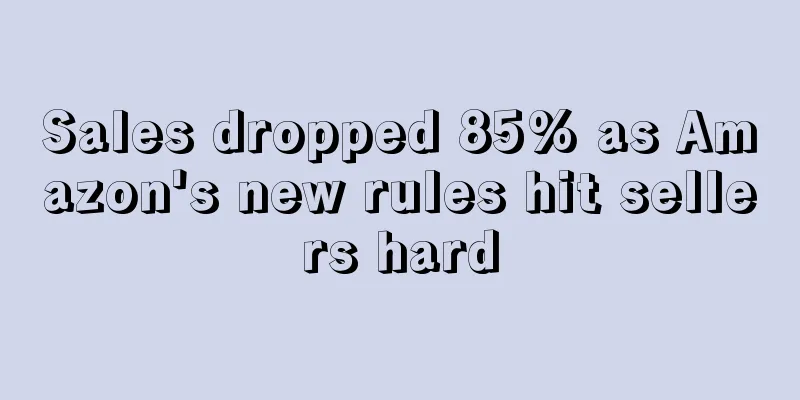Black Friday is over! Many sellers are hurt by the profit

|
This year's Black Friday Cyber Monday promotion is very different from previous years because all platforms have significantly extended the promotion period. After a long period of preheating, the "real Black Friday" that sellers have been looking forward to has finally arrived as scheduled.
However, its sales volume did not explode as expected. In previous years, the sellers’ orders or sales volume were hot topics on this day, but this year it seemed quite deserted. Some people may say: "Black Friday is mainly an offline shopping feast, consumers go to physical stores to buy, and Cyber Monday is the time when online consumption plays the leading role." But is this really the case?
Americans alone bought $10.8 billion. Seller: Where’s the order?
Transactions monitored by Adobe Analytics showed online spending on Black Friday grew 10.2% year-over-year to a record $10.8 billion, an amount Adobe said was more than double what consumers spent online on Black Friday five years ago.
However, in terms of the actual situation of sellers, the sales volume is far from being as impressive as the above data. Many sellers have reported that compared with normal times, the number of orders has increased to a certain extent, but the increase is relatively limited.
Overall, the average order volume of sellers has only increased by about two times, and many sellers said that the traffic brought by this Black Friday event is not even as good as that of Member Day and Halloween. This also caused some sellers to complain: "There is no warm atmosphere and hot feeling that Black Friday should have."
“—Today was good, but still a little short of explosion; ——This year’s Black Friday traffic doesn’t seem to be very high. Last year’s Black Friday traffic was better than this year’s. ——Generally speaking, if they can be sold out by December 15, they will basically be sold out.”
However, there are exceptions to everything in the world. On Black Friday, some sellers also saw an explosive growth in orders.
A 3C seller said that his performance in this category was very good this year, with overall sales increasing 9 times, and each account was short of goods. Another seller also revealed that the top 50 products in his subcategory were all sold out, with orders 10 times the usual, "but there is not much inventory left, most of the inventory is in 'reserved status', and it feels like it won't last the entire Black Friday and Online One period."
Another seller did not specify the specific increase in orders, but he said: "This year is amazing. Products that usually sell averagely are now selling very well. There is simply not enough to sell, and it is too late to restock. We can only watch them run out of stock."
It is worth mentioning that although the sellers have achieved good sales, their profit levels are extremely low, and some even suffer losses. For example, one seller said helplessly: "Although his sales have doubled or tripled, his profits may still be at a loss."
The reason why the number of orders increased but the profit did not is that everyone is selling at low prices. One seller said: "This year's costs are so much higher than in previous years. I thought my peers would raise their prices, but they are all still selling at low prices, even lower than in previous years."
In addition, during this year's Black Friday promotion, the main consumers seemed to be highly concentrated on the US site. Compared with the US site, the sales performance of other sites was much worse, even the European site, which is second only to the US site in size. This also led some sellers to joke that the European site seemed to have experienced a "fake Black Friday."
Black Friday sales are not good, offline and online people say that the other party is behind it
Regarding the sales situation of Black Friday this year, one seller said humorously: "I have already thought of the reason. Black Friday is the traditional offline shopping promotion festival in the United States. The online e-commerce platform still depends on Cyber Monday for explosive orders."
However, if we look at the sales situation of offline physical stores, we will find that their sales performance is also unsatisfactory.
On Friday, local time in the United States, in a shopping mall in suburban New Jersey, Abercrombie & Fitch clothing store launched a 25% discount promotion, but its sales did not show the expected hot scene. A store clerk lamented that Black Friday is no longer what it used to be, and most consumers now prefer to shop on online platforms. Since the outbreak of the epidemic, Black Friday is no longer as popular as it used to be.
According to data from some research firms, this is indeed the case. For example, in stores tracked by Sensormatic Solutions, shopper traffic on Black Friday fell 8.2% compared to 2023.
Obviously, with the poor sales performance on Black Friday this year, both offline stores and online sellers blamed each other. However, Ian believes that the actual situation is far from that simple. The main factors that led to this situation ultimately include the following two aspects:
First, traffic is distributed across multiple platforms. In the past, Black Friday promotions were mainly focused on the Amazon platform, but now, there are many emerging platforms such as Temu and SHEIN. There are more platforms, but consumers are relatively fixed. As a result, the traffic evenly distributed to each platform is bound to decrease accordingly.
An earlier survey showed that more than a quarter of Generation Z consumers in the United States plan to make their own Black Friday purchases on Temu, and 24% of consumers hope to buy their own Black Friday gifts on Shein.
Second, the battle line is extended. As we all know, this year, whether it is traditional giants such as Amazon and Walmart, or emerging platforms such as SHEIN, Temu, and TikTok shop, they all extended the duration of the Black Friday online promotion. Among them, Temu's promotion period is as long as 47 days, and it was the first to launch related promotion activities as early as October 20.
According to an earlier survey by market research firm Circana, more than 55% of holiday shoppers this year plan to start shopping before the Thanksgiving holiday. Only nearly a quarter (25%) believe they can still find the best deals on Black Friday.
The peak season has shrunk significantly, and sellers are in urgent need of changing their sales strategies
If you pay close attention, you will find that sales on not only Black Friday, but also popular sales days such as Halloween, Thanksgiving, and Christmas have become increasingly flat in recent years.
Some sellers pointed out that the overseas sales peak season used to kick off in September, but now, the so-called peak season only lasts for a dozen days after the end of Black Friday and Cyber Monday.
Specifically, the peak season, that is, the period when sales can be increased by selling at normal prices without discounts or promotions, is only from December 1 to December 19, calculated from the time dimension.
Moreover, the sales volume gained by the current peak season promotion was achieved at the expense of normal sales in November. During this period, advertising costs rose sharply, but the conversion rate fell instead of rising. However, when the overall benefits were finally calculated, it was found that this situation was even worse than having no peak season. After all, if there was no peak season, there would be no need to prepare such a large amount of goods, and the risks faced would be much smaller.
Some sellers admitted that this major promotional activity is purely for the purpose of increasing user stickiness on the platform, while the sellers themselves are just losing money and gaining publicity, which is hard work but difficult to please.
Therefore, some businesses are now gradually refusing to participate in big promotion activities, always adhering to the strategy of not giving discounts, and conducting sales business under normal circumstances.
At the same time, sellers are also taking a more normal attitude towards the peak season promotion. On Black Friday, many sellers may be constantly refreshing the order page, but some sellers are completely focused on planning new products for next year.
On Black Friday this year, a seller in Fujian doubled his sales year-on-year, which was not very good overall, but not bad either. Regardless of the result, the seller did not pay much attention to it. Because he had to ship out about 400 boxes of new products, he was too busy to check the order volume.
From the current perspective, there have indeed been many significant changes in the peak season promotions in the second half of the year. In the future, the concentrated explosive sales model formed by relying solely on traditional large-scale promotional activities such as Black Friday and Cyber Monday may be difficult to maintain. In the future, sellers need to actively explore more diversified, long-term and stable sales strategies.
Black Friday Sale |
<<: A group of cross-border tycoons emerged in Zhejiang
>>: TikTok Shop's Black Friday sales in the U.S. exceeded $100 million in a single day
Recommend
What is Redbubble? Redbubble Review, Features
<span data-docs-delta="[[20,"Redbubble&quo...
It only took SHEIN sellers 3 months to break through $1 million in monthly sales!
SHEIN's development speed has always been the...
European ports hold 48-hour strike, China's foreign minister calls on the US to lift tariffs and sanctions
Strike at major European ports may lead to berthi...
What is Scalefast? Scalefast Review, Features
Scalefast is a privately held, venture-backed com...
Many sellers quit Amazon
Amazon operations often say that you should give ...
Crash! Snowstorm in the US caused New York docks to shut down and Amazon warehouses to close
Several states in the United States have entered ...
What is W8(W-8BEN)? W8(W-8BEN) Review, Features
W8 stands for "Form W-8BEN", which is i...
The government has taken action to crack down, and 2 million e-commerce sellers may lose their jobs!
For a country with a population of 270 million an...
What is Weijun International Freight? Weijun International Freight Review, Features
Guangzhou Weijun International Freight Forwarding ...
Amazon builds a new distribution center in Washington State, and Shishi City, Fujian Province, introduces ten measures to accelerate the development of cross-border e-commerce
Amazon Air is rapidly expanding, with next-day de...
What is Habi? Habi Review, Features
Habi is a Colombian real estate transaction digit...
What is ustellartech? ustellartech Review, Features
ustellartech was founded in April 2016 by a group ...
Poland's Allegro platform launches special plan for fashion brands to attract sellers
According to foreign media reports, Poland's ...
Logistics prices are soaring, and shipping congestion may continue until June
Last year, due to the impact of the epidemic, man...
Taking multiple measures to win the "Global Double Eleven", 4PX Delivered's average daily order volume exceeded 10 million
Have you received your Double 11 packages? "...









